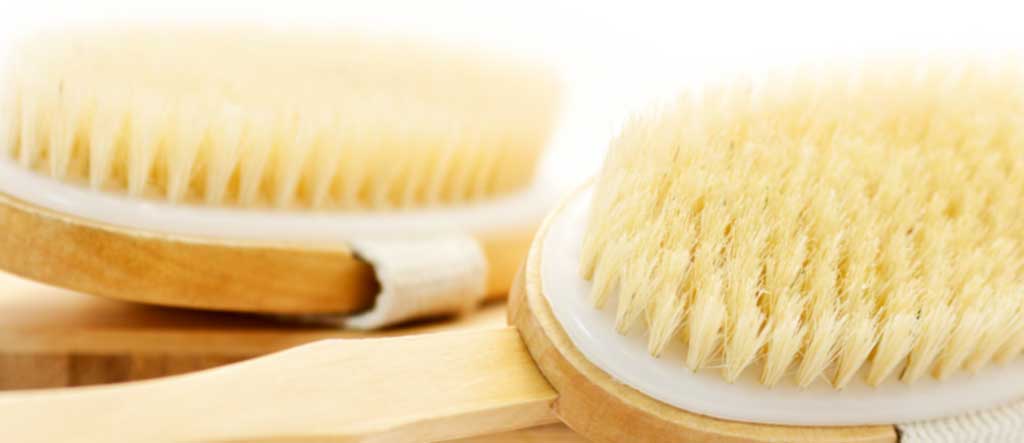Your basket is currently empty!
Dry Skin Brushing
The skin is the most lavished upon organ of the human body, it is also the biggest. The average adult is covered with approximately two square metres of skin and it accounts for about an eighth of total body weight. It is a natural boundary between our inner and outer environments, is both absorptive and eliminative.
The skin has two distinct layers, the epidermis and the dermis plus a third layer, the hypodermis, which is made up of fatty cells that lie just below the skin. The epidermis is composed primarily of dead skin cells. The bottom layer of skin called the dermis abounds with blood vessels; this is the part of the skin in which hair follicles, sweat and sebaceous glands, and nerve endings are located. The nerve endings push into the epidermis and communicate the sense of touch. Our skin is our first defence against external factors including bacteria, chemicals, and extremes of light and temperature.
The primary functions of the skin include respiration, excretion, blood and lymph circulation, immunity and the conduction of electricity. Unlike other vital organs, the skin is immediately accessible making it relatively easy to apply therapeutic treatments such as dry skin brushing and hydrotherapy.
Dry Skin Brushing
The simple practice of dry skin brushing improves all the major physiological functions of the skin delivering immediate and long-term benefits for the body as a whole, mental acuity and emotional well-being, while reducing cellulite and slowing the skin’s aging process. It is one of the best ways to stimulate the lymphatic system and elimination via the skin.
The Benefits of Dry Skin Brushing:
- Stimulates blood and lymph flow.
- Stimulates the hormone and oil glands.
- Strengthens the immune system.
- Stimulates the nervous system, tones muscles and tightens the skin.
- Removes dead skin cells, which account for about 90% of house dust.
- Reduces cellulite.
- Nurtures your body.
If toxins are unable to escape through the skin they will be stored in fat cells, resulting in fatty deposits such as cellulite or cysts, or they will re-circulate through the bloodstream stressing the kidneys, lungs and bowels.
As the skin is responsible for the excretion of approximately a quarter of the body’s waste products, any dysfunction of the skin in this field will put stress on the other three eliminative organs, namely the kidneys, the lungs and the bowels, as they will have to deal with the extra burden.
David Hoffman¹
Selecting a Dry Skin Brush
Choose a brush with natural fibre bristles and a long handle to reach all areas of your back. The bristles of a new brush can feel very stiff at first, start gently, your skin will acclimatise and the bristles do soften with use. If your skin is very sensitive choose a soft bristle brush.
How to Dry Skin Brush

- The best time is in the morning, before you shower or bathe.
- Stand naked and begin with the soles of your feet moving around to the top of your feet and ankles using circular motions. Brush all the way up your legs, using long sweeping strokes on your calves and thighs.
- Always brush towards your heart. Use circular motions around the joints.
- Continue over your hips and buttocks using circular strokes, then your abdomen and on to your back. If you are constipated spend a little longer on your abdomen to promote elimination. Similarly, concentrate a little longer on areas where you have cellulite.
- Go gently on sensitive areas such as the breasts and more firmly on areas like the soles of the feet.
- When you reach your arms, begin at your fingers and brush up your arms, toward your heart. Brush your shoulders and chest down, always in the direction of your heart. Spend a little extra time on the underarm area and on the sides of the breast to promote lymph drainage.
- Avoid brushing any areas where the skin is broken or where there is a rash, infection or wound.
To further stimulate the lymphatic system and improve circulation an alternating hot/cold shower is recommended:
7 minutes hot water, followed by 1 – 3 minutes of cold water.
How Hot and Cold Shower Therapy Works:
The application of cold water drives the flow of blood inwards to the internal organs. The cold water then draws the blood outwards toward the skin. Alternating between hot and cold stimulates blood and lymph circulation. This can help to increase the rate of detoxification and move nutrients more readily to various parts of the body.
NOTE: Don’t force yourself to endure extreme temperatures, moderate temperatures can work just as well. Listen to your body. If you find it hard to get started with hot/cold showers start off by ending your shower on cold water, paradoxically you will find that you are less inclined to shiver when you exit the shower and you will definitely feel more energised.
¹ Hoffman, D. Holistic Herbal, A Safe Practical Guide to Making and Using Herbal Remedies. 3rd Edition. Great Britain: Thorsons, Harper Collins Publishers; 1990. P. 76

